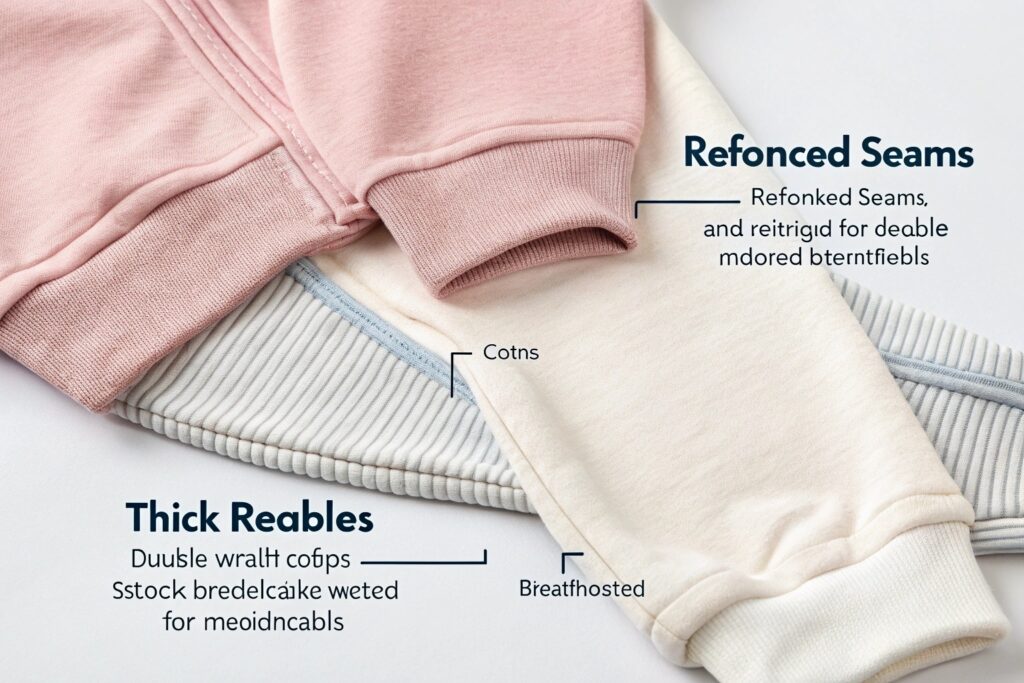Babies don’t walk fashion runways—they crawl, tumble, and explore. And that means not all clothes are built for that level of action.
Different clothes exist for children to play in because regular outfits can’t support the movement, safety, and durability required during active moments.
As a baby clothing manufacturer, I’ve helped countless brands create collections that meet the needs of play—because that’s where childhood really happens.
What fabrics are best for active newborn clothing?
Most parents think “soft” is enough. But when babies are active, clothing needs to do more—bend, stretch, breathe, and protect.
The best fabrics for active newborns are soft, stretchy, and breathable—like cotton blends, bamboo, and modal—offering mobility and skin safety.

Why do cotton-spandex blends outperform 100% cotton in baby playwear?
While 100% cotton is breathable and soft, it lacks stretch. Active babies need garments that move with them—especially around the knees, elbows, and waist. That’s why many brands use a cotton-spandex or cotton-modal blend. These fabrics allow for rolling, crawling, and squatting without resistance. At Fumao Clothing, we use 95% cotton and 5% spandex for most of our activewear lines. It offers the softness of cotton but with extra flexibility—reducing tears and increasing comfort.
How does bamboo viscose help regulate body temperature during physical activity?
Bamboo viscose is not only silky-soft—it also has natural thermoregulating properties. Babies can’t regulate their body temperature like adults. So overheating is a concern. Bamboo fabrics wick moisture away, keeping babies cool during movement. For activewear, we recommend bamboo blends for warmer climates or summer months. Several of our buyers from Southern U.S. states prefer bamboo fabric for their baby rompers and jumpsuits.
How does playwear differ from everyday baby outfits?
Parents might not realize it at first—but that “cute” outfit they bought for their baby shower isn’t built for crawling on hardwood or rolling in the grass.
Playwear differs from everyday outfits in fabric durability, stretch, seam construction, and design simplicity—all made to support movement and minimize hazards.

What makes playwear more durable and functional than standard infant clothing?
Playwear often uses reinforced seams, double-stitching, and thicker knits. These prevent tearing at stress points like the knees or underarms. In our factory, playwear garments go through stretch tests—mimicking crawling and tugging—to ensure they hold up. We’ve even helped brands create padded-knee leggings for babies learning to walk. These don’t exist in standard babywear. Our clients want long-lasting clothes because replacements interrupt sales cycles and erode customer trust.
How does the design of playwear reduce choking and injury risks?
Playwear minimizes decorative elements like buttons, bows, and snaps. Instead, it relies on hidden zippers, fold-over cuffs, and elastic hems. These prevent babies from pulling pieces into their mouths or getting caught on playground surfaces. We work with babywear brands that follow ASTM F1816 standards for drawstring and small-part safety. Regular outfits might look nice, but for play, safety-first design is essential. And it’s something we help our buyers test during the sampling phase.
Why do babies need separate clothes for playtime?
To an adult, all baby clothes might look the same. But to a crawling child? That difference is huge.
Babies need separate clothes for playtime to support full-range movement, reduce skin friction, and protect them from minor abrasions during exploration.

How do movement patterns in babies require specialized clothing features?
Babies spend most of their active time on all fours. This means knees, elbows, and bellies are in constant contact with the floor. Standard onesies with snaps or rough inner stitching cause discomfort or rashes. That’s why we design playwear with flatlock seams, gussets, and no internal tags. For one brand we work with in California, we added anti-slip grips to the knees of crawler pants—a hit with parents and retailers alike. Clothes need to match the motor stage of the baby.
What are the long-term benefits for parents using dedicated playwear?
Using designated playwear helps parents preserve nicer outfits for outings. It also cuts down on laundry, as playwear is often pre-treated for stain resistance. Some of our clients even offer subscription bundles: one line for everyday wear, and one for activewear. Parents appreciate the separation—it simplifies dressing decisions and keeps clothes looking better, longer. And in resale or hand-me-down markets, playwear with reinforced construction holds value.
Are breathable baby clothes safer for movement?
Breathable doesn’t just mean “cool.” It means freedom from overheating, chafing, and sweat retention—which can all lead to discomfort or even heat rashes.
Yes—breathable baby clothes are safer for movement because they reduce the risk of overheating, skin irritation, and restricted airflow during physical activity.

How does airflow in fabric affect baby health during extended activity?
Active babies sweat, even if we don’t notice it. If moisture builds up, it can cause rashes and lead to overheating—especially in warm climates. Breathable fabrics like jersey cotton, bamboo knits, and mesh weaves allow air to circulate, preventing this buildup. Our Fumao Clothing team uses GSM measurements to balance breathability with coverage. For summer activewear, we aim for 140–160 GSM to keep the baby dry but protected.
Why do brands prefer tagless, lightweight, and open-weave designs for movement?
Tagless construction avoids skin friction, especially at the neck and back. Lightweight fabrics keep garments from weighing down during crawling or walking. And open-weave knits offer passive ventilation. These aren’t luxury features—they’re safety essentials. We once had a client request mesh panels under the arms of play bodysuits. Parents raved. Because when a baby is on the move, every design detail matters.
Conclusion
Play isn’t a luxury—it’s a core part of development. And that’s why babies need different clothes for it. Clothes that move with them, protect them, and keep them comfortable every step of the way.










